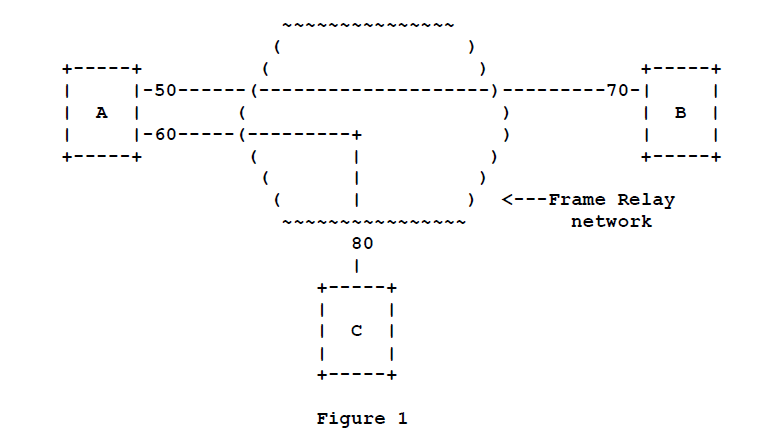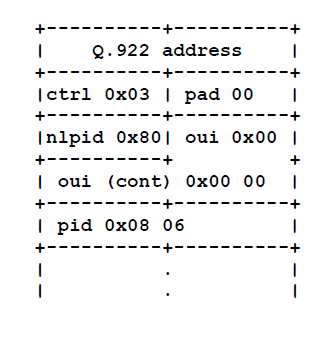
Inverse Address Resolution Protocol (InARP)
Posted on |
Inverse Address Resolution Protocol
Introduction
This document will rely heavily on Frame Relay as an example of how the Inverse Address Resolution Protocol (InARP) can be useful. It is not, however, intended that InARP be used exclusively with Frame Relay. InARP may be used in any network that provides destination hardware addresses without indicating corresponding protocol addresses.
This document describes additions to ARP that will allow a station to request a protocol address corresponding to a given hardware address. Specifically, this applies to Frame Relay stations that may have a Data Link Connection Identifier (DLCI), the Frame Relay equivalent of a hardware address, associated with an established Permanent Virtual Circuit (PVC), but do not know the protocol address of the station on the other side of this connection. It will also apply to other networks with similar circumstances.
Motivation
The motivation for the development of Inverse ARP is a result of the desire to make dynamic address resolution within Frame Relay both possible and efficient. Permanent virtual circuits (PVCs) and eventually switched virtual circuits (SVCs) are identified by a Data Link Connection Identifier (DLCI). These DLCIs define a single virtual connection through the wide area network (WAN) and may be thought of as the Frame Relay equivalent to a hardware address.
Periodically, through the exchange of signaling messages, a network may announce a new virtual circuit with its corresponding DLCI. Unfortunately, protocol addressing is not included in the announcement. The station receiving such an indication will learn of the new connection, but will not be able to address the other side. Without a new configuration or a mechanism for discovering the protocol address of the other side, this new virtual circuit is unusable.
Other resolution methods were considered to solve the problems but were rejected. Reverse ARP [4], for example, seemed like a good candidate, but the response to a request is the protocol address of the requesting station, not the station receiving the request. IP specific mechanisms were limiting since they would not allow resolution of other protocols other than IP. For this reason, the ARP protocol was expanded.
Inverse Address Resolution Protocol (InARP) will allow a Frame Relay station to discover the protocol address of a station associated with the virtual circuit. It is more efficient than sending ARP messages on every VC for every address the system wants to resolve and it is more flexible than relying on static configuration.
Packet Format
Possible values for hardware and protocol types are the same as those for ARP and may be found in the current Assigned Numbers RFC [2].
Length of the hardware and protocol address are dependent on the environment in which InARP is running. For example, if IP is running over Frame Relay, the hardware address length is either 2, 3, or 4, and the protocol address length is 4.
The operation code indicates the type of message, request or response.
Protocol Operation
Basic InARP operates essentially the same as ARP with the exception that InARP does not broadcast requests. This is because the hardware address of the destination station is already known.
When an interface supporting InARP becomes active, it should initiate the InARP protocol and format InARP requests for each active PVC for which InARP is active. To do this, a requesting station simply formats a request by inserting its source hardware, source protocol addresses, and the known target hardware address. It then zero fills the target protocol address field. Finally, it will encapsulate the packet for the specific network and send it directly to the target station.
Upon receiving an InARP request, a station may put the requester’s protocol address/hardware address mapping into its ARP cache as it would any ARP request. Unlike other ARP requests, however, the receiving station may assume that any InARP request it receives is destined for it. For every InARP request, the receiving station should format a proper response using the source addresses from the request as the target addresses of the response. If the station is unable or unwilling to reply, it ignores the request.
When the requesting station receives the InARP response, it may complete the ARP table entry and use the provided address information. Note: as with ARP, information learned via InARP may be aged or invalidated under certain circumstances.
1. Operation with Multi-Addressed Hosts
In the context of this discussion, a multi-addressed host will refer to a host that has multiple protocol addresses assigned to a single interface. If such a station receives an InARP request, it must choose one address with which to respond. To make such a selection, the receiving station must first look at the protocol address of the requesting station, and then respond with the protocol address corresponding to the network of the requester. For example, if the requesting station is probing for an IP address, the responding multi-addressed station should respond with an IP address which corresponds to the same subnet as the requesting station. If the station does not have an address that is appropriate for the request it should not respond. In the IP example, if the receiving station does not have an IP address assigned to the interface that is a part of the requested subnet, the receiving station would not respond.
A multi-addressed host should send an InARP request for each of the addresses defined for the given interface. It should be noted, however, that the receiving side may answer some or none of the requests depending on its configuration.
2. Protocol Operation Within Frame Relay
One case where Inverse ARP can be used is on a frame relay interface which supports signaling of DLCIs via a data link management interface. An InARP equipped station connected to such an interface will format an InARP request and address it to the new virtual circuit. If the other side supports InARP, it may return a response indicating the protocol address requested.
In a frame relay environment, InARP packets are encapsulated using the NLPID/SNAP format defined in [3] which indicates the ARP protocol. Specifically, the packet encapsulation will be as follows:

Note that the Q.922 addresses specified have the C/R, FECN, BECN, and DE bits set to zero.
Procedures for using InARP over a Frame Relay network are as follows:
Because DLCIs within most Frame Relay networks have only local significance, an end station will not have a specific DLCI assigned to the InARP request or response. Fortunately, the Frame Relay network does provide a method for obtaining the correct DLCIs. The solution proposed for the locally addressed Frame Relay network below will work equally well for a network where DLCIs have global significance.
The DLCI carried within the Frame Relay header is modified as it traverses the network. When the packet arrives at its destination, the DLCI has been set to the value that, from the standpoint of the receiving station, corresponds to the sending station. For example, in figure 1 below, if station A were to send a message to station B, it would place DLCI 50 in the Frame Relay header. When station B received this message, however, the DLCI would have been modified by the network and would appear to B as DLCI 70.


For InARP, the FECN, BECN, C/R and DE bits are assumed to be 0.
When an InARP message reaches a destination, all hardware addresses will be invalid. The address found in the frame header will, however, be correct. Though it does violate the purity of layering, Frame Relay may use the address in the header as the sender hardware address. It should also be noted that the target hardware address, in both the InARP request and response, will also be invalid. This should not cause problems since InARP does not rely on these fields and in fact, an implementation may zero fill or ignore the target hardware address field entirely.
Using figure 1 as an example, station A may use Inverse ARP to discover the protocol address of the station associated with its DLCI 50. The Inverse ARP request would be as follows:
[2] Reynolds, J., and J. Postel, “Assigned Numbers”, STD 2, RFC 1700, October 1994. See also: http://www.iana.org/numbers.html
[3] Bradley, T., Brown, C., and A. Malis, “Multiprotocol Interconnect over Frame Relay”, RFC 1490, July 1993.
[4] Finlayson, R., Mann, R., Mogul, J., and M. Theimer, “A Reverse Address Resolution Protocol”, STD 38, RFC 903, June 1984.
[5] Bradner, S., “Key words for use in RFCs to Indicate Requirement Levels”, BCP 14, RFC 2119, March 1997.
[6] Information technology – Telecommunications and Information Exchange between systems – Protocol Identification in the Network Layer, ISO/IEC TR 9577: 1992.







